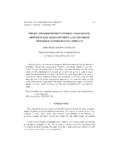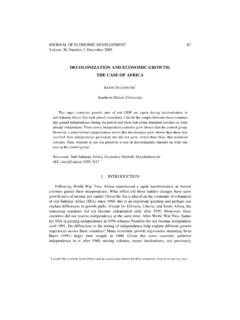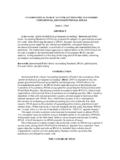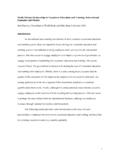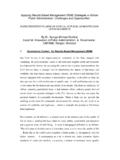Transcription of PUBLIC-PRIVATE SECTOR RELATIONSHIPS IN …
1 JOURNAL OF ECONOMIC DEVELOPMENT 1 Volume 28, Number 2, December 2003 PUBLIC-PRIVATE SECTOR RELATIONSHIPS IN developing countries MARTIN J. STAAB Georgetown University This paper refutes the conventional wisdom, bolstered in the wake of the Asian financial crisis that governments should not become too friendly with the private SECTOR but, instead, should remain neutral and at arms-length distance. The empirical findings presented here indicate that countries in which governments have forged close and cooperative working RELATIONSHIPS with the private SECTOR have had much greater economic success.
2 Furthermore, countries with more business-friendly PUBLIC-PRIVATE SECTOR RELATIONSHIPS tend to exhibit greater positive responsiveness to pro-growth policy reforms. In many developing countries today, where PUBLIC-PRIVATE SECTOR RELATIONSHIPS are characterized more by mistrust than cooperation, more not less collaboration is needed to spur economic growth. The art of governance, however, is avoiding state capture and not letting this partnership degenerate into favoritism and cronyism. Keywords: PUBLIC-PRIVATE SECTOR RELATIONSHIPS , Governance JEL classification: O1 1. INTRODUCTION Choosing the right policies to promote economic growth and development is, of course, essential.
3 countries that have relied on free, open and competitive markets and maintained macroeconomic stability have generally performed better than those that have not adopted these policies (Fischer (1993) and Sachs and Warner (1995)). The high-performing economies of East Asia are often cited as a dramatic example of this success (Leipziger and Thomas (1993)). However, there are developing countries today that have also moved in this same, more liberalized, policy direction, albeit more recently, but have not yet experienced sustained rapid economic growth. Why do the same pro-growth policies that succeed in one country fail or have little impact in another?
4 Is it just that not enough time has elapsed or that the policy dosage is still too small? In seeking to answer these questions, this paper tests the hypothesis that the quality of PUBLIC-PRIVATE SECTOR RELATIONSHIPS or, more specifically, the degree of trust and MARTIN J. STAAB 2 cooperation between government and private SECTOR agents, is an important factor that needs to be taken into account in explaining differences in economic performance across countries with similar policy Just getting policies right, as important as that is, may not be enough to promote growth and development in countries where strong and effective PUBLIC-PRIVATE SECTOR RELATIONSHIPS are lacking.
5 To measure PUBLIC-PRIVATE SECTOR RELATIONSHIPS , an index, called the Business- Friendly (B-F) Index, is constructed. The B-F Index is tested in a multiple regression model to estimate its importance in explaining economic performance. Panel data are used, covering a wide cross section of developing countries for the last two decades (1980-97). 2. DEFINING PUBLIC-PRIVATE SECTOR RELATIONSHIPS Most studies of PUBLIC-PRIVATE SECTOR RELATIONSHIPS tend to concentrate on the functional nature of these RELATIONSHIPS or, more specifically, on the obstacles, mainly defined in terms of the policies and actions taken by government, to doing business in a country (Brunetti, Kisunko and Weder (1998)).
6 However, the focus here is not these rules of the game as such, but rather on the manner in which they are implemented. The term relationship describes how civil servants, charged with the responsibility of implementing policies, and private SECTOR agents, who must respond to those incentives, interact in terms of the mutual trust and support that are provided. At one end of this spectrum, are those RELATIONSHIPS where governments are generally helpful, friendly and supportive, and, at the other end, are those mostly dysfunctional, predatory or adversarial RELATIONSHIPS in which governments may regard the private SECTOR only as a source of economic rents.
7 One implication of this definition is that governments with similar functional responsibilities ( , market-oriented economies) could have quite different (friendly or unfriendly) PUBLIC-PRIVATE SECTOR RELATIONSHIPS . Therefore, one cannot, automatically assume that market-friendly implies business-friendly. Furthermore, business-friendly should not be confused with cronyism, which refers to favoritism or the preferential treatment accorded a select number of businesses or individuals. To the contrary, the B-F Index is intended to measure how the public SECTOR relates to the private SECTOR as a whole, not just to a privileged part of it.
8 1 Mahbub ul Haq (1997) was one of the first to recognize the importance of this relationship . After comparing South Asia s economic performance with East Asia s, and finding that the usually cited factors (human and physical capital and outward orientation), cannot adequately explain the differences, Haq concludes that the missing explanation lies in the close, cooperative relationship between the public and private sectors in East Asia in contrast to the paternalistic relationship in South Asia. PUBLIC-PRIVATE SECTOR RELATIONSHIPS IN developing countries 3 3.
9 THE BUSINESS-FRIENDLY INDEX The B-F Index is composed of four subcomponents. Each subcomponent and the construction of the B-F Index are described below. The Subcomponents Government Supportiveness One way by which to gauge government supportiveness is to examine the pattern of public expenditure. For example, public investment in infrastructure, such as transport, power, water and telecommunications, directly supports and enhances the productivity of private SECTOR investments (Blejer and Khan (1984), Greene and Villanueva (1991), Wai and Wong (1982), and Hadjimichael et al.)
10 (1995)). Because per capita power consumption is correlated with the other indices of infrastructure adequacy and has the advantage of having data available for a large number of developing countries over the last several decades, it was used as a proxy for this Government Disposition Towards the private SECTOR To help capture the manner and mindset, either friendly or otherwise, by which governments relate to private enterprises, a second subcomponent was defined. Because business-friendly governments generally do not tax business enterprises excessively, especially when alternative and more efficient ways to raise tax revenue exist, the highest marginal rate of corporate taxation was used as a proxy for this subcomponent.
